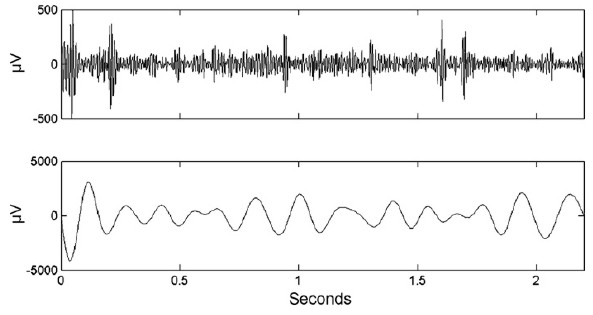Synchronization
Source Reconstruction
Nested Oscillations
Brain Computer Interfacing

Physiological basis of M/EEG signals: forward models and source reconstruction
( PPT version , PDF version ) MSc Advanced Neuroimaging, ION, UCL, Dec 2 2008.
Litvak V, Mattout J, Kiebel S, Phillips C, Henson R, Kilner J, Barnes G, Oost-
enveld R, Daunizeau J, Flandin G, Penny W, Friston K. (2011)
EEG and MEG data
analysis in SPM8.
Comput Intell Neurosci:852961.

W.D. Penny,
S.J. Kiebel,
J.M. Kilner,
and M.D. Rugg.
Event-related brain dynamics.
Trends in Neuroscience,
25(8):387-389,
2002.

A. Jafarpour, G. Barnes, L. Fuentemilla, E. Duzel and W. Penny (2013).
Population level inference for multivariate MEG analysis.
PLoS One. 8(8), e71305.

Synchronization can be studied using coupled oscillator models. Synchronization processes in the brain may provide a substrate for information transfer among different brain regions.

The picture above shows a flow diagram of phase dynamics as estimated from three brain regions source reconstructed from MEG data, with the x-axis being phase difference between Medial Temporal Lobe (MTL) and Visual Cortex (VIS), and the y-axis being phase difference between Inferior Frontal Gyrus (IFG) and VIS. Red dots show (fitted) phase trajectories for ten working memory trials, which all converge such that the phase difference between IFG and MTL is almost zero. Additionally, Bayesian model comparison revealed that VIS enslaves IFG and MTL.
W Penny,
V Litvak,
L Fuentemilla,
E Duzel,
and K Friston.
Dynamic Causal Models for Phase Coupling.
J Neurosci Methods,
183(1):19-30,
2009.

The problem of source reconstruction is how to estimate cortical sources at (potentially) thousands of points on the cortical surface (or within the volume of the brain) given only tens or hundreds of sensor measurements. The problem is naturally addressed in a Bayesian framework in which the priors provide the required constraints.
 C Stevenson, M Brookes, J Lopez, L Troebinger, J Mattout , W Penny, P Morris, A Hillebrand, R Henson, G Barnes (2014).
Does function fit structure? A ground truth for non-invasive neuroimaging.
Neuroimage, Accepted ,
C Stevenson, M Brookes, J Lopez, L Troebinger, J Mattout , W Penny, P Morris, A Hillebrand, R Henson, G Barnes (2014).
Does function fit structure? A ground truth for non-invasive neuroimaging.
Neuroimage, Accepted ,

J.D. Lopez and W. Penny and J. Espinosa and G. Barnes (2012).
A general Bayesian treatment for MEG source reconstruction incorporating lead field uncertainty.
Neuroimage 60:1194-1204.

V Litvak, A Eusebio, A Jha, R Oostenveld, G Barnes, W Penny, L Zrinzo, M Hariz, P Limousin, K Friston, P Brown.
Optimized beamforming for simultaneous MEG and intracranial local field potential recordings in deep brain stimulation patients.
Neuroimage,
Jan 4 2010; Epub ahead of print.

N Trujillo-Barreto,
E Aubert-Vazquez,
and W Penny.
Bayesian M/EEG source reconstruction with spatio-temporal priors.
.
Neuroimage,
39(1):318-35,
2008.

J. Mattout,
C. Phillips,
W.D. Penny,
M. Rugg,
and K.J. Friston.
MEG source localization under multiple constraints: an extended Bayesian framework.
NeuroImage,
30(3):753-767,
2006.
 
Nested oscillations are of interest to neuroscientists as, for example, the nesting of gamma bursts (30-80Hz) within theta oscillations (4-8Hz) is thought to underlie aspects of short term memory.

The picture above shows burst of gamma activity aligned with theta troughs in ECOG data.
W D Penny,
E Duzel,
K J Miller,
and J G Ojemann.
Testing for nested oscillation.
J Neurosci Methods,
174(1):50-61,
2008.

E. Curran,
P. Sykacek,
M.Stokes,
S.J. Roberts,
W. Penny,
I. Johnsrude,
and A.M. Owen.
Cognitive Tasks for Driving a Brain Computer Interfacing System: A Pilot Study.
IEEE Transactions on Neural Systems and Rehabilitation Engineering,
12(1):48-54,
2004.
S.J. Roberts and W.D. Penny.
Real-Time Brain-Computer Interfacing: A Preliminary Study Using Bayesian Learning.
Medical and Biological Engineering and Computing,
38(1):56-61,
2000.

W.D. Penny,
E. Curran S.J. Roberts,
and M. Stokes.
EEG-based communication: a pattern recognition approach.
IEEE Transactions on Rehabilitation Engineering,
8(2),
1999.

S.J. Roberts,
W. Penny,
and I. Rezek.
Temporal and spatial complexity measures for EEG-based brain-computer interfacing.
Medical and Biological Engineering and Computing,
37(1):93-99,
1998.

|



